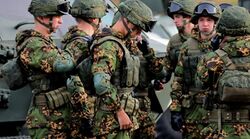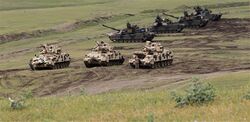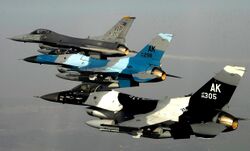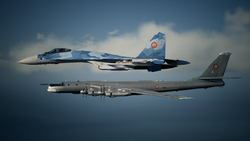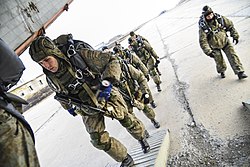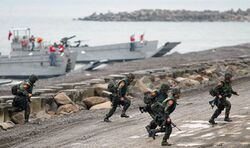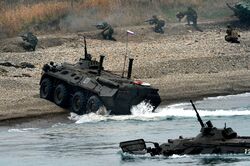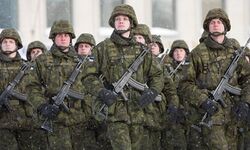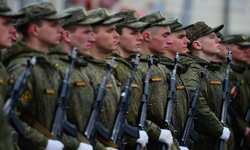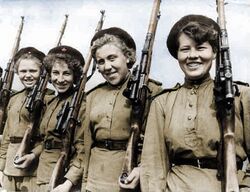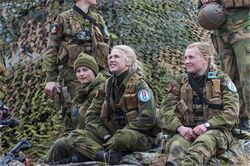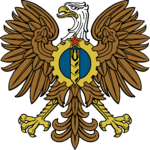Military of Florencia: Difference between revisions
| Line 242: | Line 242: | ||
During their term of service a recruit undergoes basic combat training, basic individual job training, partakes in training exercises, and can be embedded with the Union Army for technical job experience. A draftee is expected to become a competent riflemen by the completion of their training and understand the basics of their occupational specialty. | During their term of service a recruit undergoes basic combat training, basic individual job training, partakes in training exercises, and can be embedded with the Union Army for technical job experience. A draftee is expected to become a competent riflemen by the completion of their training and understand the basics of their occupational specialty. | ||
[[File:UnionDraftees.png|250px|thumb|right|Over | [[File:UnionDraftees.png|250px|thumb|right|Over 400,000 persons serve in the Standing Guards]] | ||
The secondary peacetime role of the guard is to act as a work corps and community outreach program. After completing their basic training portion, a Scarlet Guardsmen can expect to find themselves in the outdoors for weeks at a time during a field training exercise, and then return to civilization to partake in road construction or working within an elderly town home. The conservation and development of Florencia's natural resources along with social work in educational, agricultural, and community programs is paramount to the mission of the guards. In addition Scarlet Guard training brigades are expected to and prepared to aid the federal and constituent republican governments in disaster relief response. This sort of work would typically be coordinated with a republic's National Militia component. Every year over | The secondary peacetime role of the guard is to act as a work corps and community outreach program. After completing their basic training portion, a Scarlet Guardsmen can expect to find themselves in the outdoors for weeks at a time during a field training exercise, and then return to civilization to partake in road construction or working within an elderly town home. The conservation and development of Florencia's natural resources along with social work in educational, agricultural, and community programs is paramount to the mission of the guards. In addition Scarlet Guard training brigades are expected to and prepared to aid the federal and constituent republican governments in disaster relief response. This sort of work would typically be coordinated with a republic's National Militia component. Every year over 400,000 draftees pass through the Standing Scarlet Guards before returning to civilian life as a reservist, or pursuing a professional career in the military or policing. | ||
===Unorganized Scarlet Guards=== | ===Unorganized Scarlet Guards=== | ||
Revision as of 06:35, 10 April 2020
| Union Defense Forces | |
|---|---|
 Banner of the UDF | |
| Motto | "In Defense of the Motherland" |
| Founded | 1866 |
| Current form | 1920 |
| Service branches |
|
| Headquarters | The Citadel, Saint Vera, Florencia |
| Leadership | |
| Supreme Commander in Chief of the UDF | Chancellor Maxim K. Tyrol |
| Secretary of the War Department | Chessa Impala |
| Personnel | |
| Military age | 17 |
| Conscription | 6 months minimum; varies by job |
| Available for military service | 12 million, age 17-50 (2019) |
| Reaching military age annually | 2 million (2019) |
| Active personnel | 1.2 million active personnel |
| Reserve personnel | 2.2 million organized reserves 7 million unorganized reserves |
| Expenditure | |
| Budget | $249 billion |
| Percent of GDP | 3.5% |
| Industry | |
| Domestic suppliers | Florencia |
| Foreign suppliers | Zhenia |
The Florencian military is at the forefront of the world's armed forces, it is a well oiled, well motivated machine fueled by an extensive military-industrial complex. The Chancellor is the Supreme Commander-in-Chief of the Union Defense Forces (UDF), National Militia (NM), and Scarlet Guards (SG). Together they are among some of the best equipped and well motivated armies in the world.
Military spending is a major aspect of the Union budget, typically around 10% of the GDP is committed to the military. This large budget and a well dedicated arms industry contributes to a cutting edge air force, expanding navy, and robust land force equipped with the most modern small arms, armored vehicles, aviation assets, and naval vessels.
Command and Organization
National Defense Committee and the Stavka
The Department of War (DoW) is an executive office within the cabinet charged with coordinating and supervising all agencies and functions of the Union concerned directly with national security and the military. Nominal administration of the military establishment is exercised by a civilian advisory board, the National Defense Committee—which includes the chief commissioner of the Commission for Security and Order (ComSec), director of the Office of Strategic Services, directors of nationalized war industries, in addition to representatives and senators from the All-Union Congress with invested expertise in national defense. The Secretary of the War Department is the principle assistant to the Executive Council on all matters relating to the defense of the nation.
Operational authority of the War Department is invested with the Stavka High Command of the Military, the senior uniformed general staff of the armed forces. The chairman of the Stavka is the highest ranking and most senior officer within the Union military and operational commander-in-chief of the Union Defense Forces, National Militia, and the Scarlet Guards. The Chairman's authority of the military is second only to the Chancellor and All-Union Congress.
A popular misnomer in the Florencian public and military itself is colloquially referring to both the Stavka High Command and National Defense Committee collectively as the Stavka.
Structure
The National Defense Act of 1920 established the military system in its present form. Disparate imperial army regiments and revolutionary volunteer militias loyal to the provisional government where synthesized into a new military representing the goals of the revolution. The result was a tripartite system of All-Union, constituent republic, and mass militarized organizations—the Union Defense Forces, National Militia, and Scarlet Guards. These forces are further supplemented by border troops administered by the Department of Justice and internal troops under the Commission of Security and Order.
The military would have been rebuilt from the ground up with the ideology of the 1919 revolution imprinted into the fiber of a traditionally conservative and bourgeoisie orientated organization. Three values in particular would be paramount in the transformation of the Florencian military; an armed populace, universal conscription, and military democracy.
Imperial tyranny had sought to disarm an entire population so as to gain complete autocratic control, an armed nation thus has the right and responsibility to be a bulwark against reactionary oppression, both foreign and domestic. The right to bear arms in the Florencian Union is considered sacrosanct. Reservist militiamen are permitted to safely store appropriate ammunition and service weapons in their private homes, subject to a military audit of course.
The notion of an armed nation goes hand in hand with the universal conscription practiced by the UFR. Every able bodied citizen that has turned 19 or graduated high school is expected to perform a year of service in the Standing Scarlet Guards. The constituent republic organized National Militia, the professional Union Defense Forces, federal managed reserves, and law enforcement agencies recruit volunteers who have graduated from the standing guards. Should a graduate not pursue a vocation in national security, they would be rolled in the Unorganized Scarlet Guards and be free to pursue their life as a civilian, subject to yearly refresher courses or training exercises. Should a citizen be a conscious objector or be unfit for national service would perform alternate, charity, or auxiliary work for a full year.
The ideology of democracy was a leading factor for the revolution and like how such values revolutionized Florencian civil society, so did democracy transform the military. The UFS is unique in it's commitment to military democracy: soldiers's councils, elections of NCO's, and a less rigid code of military discipline characterize this democratic process.
History
Revolutionary Era
Revolting sailors, defecting imperial army regiments, mobilized worker's militias.
Later experimenting with tanks and airborne forces in the 30's.
Huge Scarlet Guards, minor national militia and small army
Patriotic War
Big ass army, kinda tiny navy, too man strategic bombers.
Though it's demobilized Florencia keeps way too many troops on payroll still.
1968 Reorganization and 1970's Reforms
Creation of the Strategic Weapons Command and Air Defense Forces of the Republics, re-subordination of the Army Air Forces. Shrinking the army in order to create a more lighter, mobile force with a concentration on regional conflicts.
1990's Reforms
Expanding the navy, marine corps, and airborne in order to achieve continental supremacy in the event of war. Drastically shrinking the nuclear forces. Getting rid of more national militia divisions as well as scaling back the scope of the Scarlet Guards
Modern Era
Continued modernization and further expansion of the navy alongside further contraction of the scarlet guards to expand Florencia's global outreach and expeditionary capabilities. Plus stealth fighters are a thing now
Branches
The Union Defense Forces (UDF) is the professional standing military of the Florencian Republics and consists of two branches and four independent armed services: the Union Army, Republican Navy, Union Strategic Weapons Command, the Air Defense Forces of the Republics, the All-Union Marine Corps, and the Union Stellar Forces Command. A byproduct of revolutionary values and federalism places the structure of the active professional armed forces separate of the massed reservist levy force in the form of the Scarlet Guards. However given the sole focus of the Scarlet Guards as a ground training contingent, both the Union Air Defense Forces and Republican Navy organize reservist command formations with a pool of former airmen and sailors.
The order of precedence and importance of the branches and independent armed services is as follows; Union Strategic Weapons Command, Union Army, Air Defense Forces of the Republics, Republican Navy, All-Union Marine Corps, and the Union Stellar Forces Command. In theory however all six armed services receive equal representation within the Stavka High Command. This also isn't to say that the Marine Corps and Stellar Forces are weak, just that the other four branches are stronger.
Each armed service can be further broken up into it's own constituent armed services. For the case of the Navy this is the submarine force, surface ships, naval aviation, special purpose troops, and coastal troops. The Air Defense Forces of the Republics feature fighter aviation, artillery anti-air, and radio-technical troops. The Union Army is unique in that it has four equal components which are then separated into their own constituent armed services.
At the head of each and branch or armed service is a Commander-in-Chief. The power of these commanders differs between branches. Three of them, the heads of the Union Army, Republican Navy, and All-Union Marine Corps, perform nothing more than administrative functions. Whereas the commanders of Strategic Weapons, the Air Defense Forces, Stellar Forces are responsible for both the administration and operation of their services. This discrepancy between the standings of the commander-in-chiefs is due to the fact the Army, Navy, and Marines are expected to cooperate and function closely together. Florencian military doctrine demands the close cooperation between these three services in the spirit of combined arms. This theory is exemplified by the unified strategic directions, which combine operational forces from all three of those branches subordinate to the Stavka. Likewise the more specialized services of air defense, strategic weapons, and space warfare act largely independent and subordinate only to the Stavka.
Union Army (UA)
The Union Army is the oldest, largest, and most diversified branch within the Union Defense Forces. It traces it's lineage to defected Imperial Army units and rural citizen militias of 1919. In many ways the Union Army is a microcosm of the rest of the Defense Forces, with their own rocketry troops, air defense troops, aircraft, and paratroopers. Originally a loose grouping of patriotic rebels resisting tyranny, the army has grown exponentially in terms of size and power. The mission of the Army is the defense of the Florenian people and territory on the land and air. To fulfill this mission the army maintains extensive commands, deploys a wide range of weapons and vehicles, and makes a great use of special purpose troops.
The Union Army does not administer a reservist formation directly subordinate to All-Union command. The separate conscript training organization that is Scarlet Guards in addition to the professional reservist National Militia fill this void. For all intents and purposes the Scarlet Guards and constituent republican ran National Militias are de facto organized as the reservist formation of the Union Army. Replacements from the guards would replenish regular army units during wartime, national militia units operate alongside their active counterparts, and all forces ultimately fall under operational authority to the Stavka.
For administrative purposes the Union Army is divided into the Army Ground Forces (training and procurement of combat troops and equipment), Army Rear Forces (rear support services that provide the material, infrastructure, and other miscellaneous services), Union Army Air Forces (frontal aviation, strategic bombers, mobile anti-air defense troops) and the Air Descent Troops (mechanized paratrooper and air deployable guerrilla units). Each of these four equal components are lead by commanders who, like the commander-in-chief of the Union Army itself, are administrative heads responsible for the training and equipping of their forces. This isn't necessarily always practiced by both commanders of both the Union Army Air Forces and Air Descent Forces though.
Union Army Air Forces
The Union Army Air Forces has had a confusing history within the Defense Forces. Originally conceived as the Army Air Fleet following the renaming of the former Imperial Air Service in 1919. By the 1930's it had grown more substantial in size and was re-purposed as the Union Army Air Corps in 1937. The Florencian Republics entry into the Second World War would see an unprecedented growth of the Army Air Corps, which was soon reorganized into the Army Air Forces to be a component equal to that of the ground, rear, and later airborne forces.
During the course of the Second World War the Army Air Forces would continually act and strive to be further independent from Army Command. The commander in chiefs of the Army Air Forces saw their purpose of winning the war with a large fleet of strategic bombers to crush the industrial heartland of Florencia's enemies and terrorize it's populations. General Headquarters Army saw the purpose of the Army Air Forces to provide front line aviation assets in support of the ground troops. Ultimately following the Second World War the Army Air Forces were separated into their own branch, the Union Air Force in 1947. However some front line ground attack aviation assets would remain under Army control.
The Union Air Force was to have the duel purpose of managing Florencia's strategic bomber fleet as well as to provide for the aerospace defense of the Republics. Though, like the second world war they took to the management of an extensive bomber fleet to be their foremost duty. When the Florencian Republics became a nuclear power in 1953, Air Force command was quick to monopolize on their piece of the nuclear triad. In 1965 a congressional committee began an investigation into the strength and procedures of the Union Air Force. The committee discovered that the Air Force had largely neglected it's purpose of aerospace defense, instead pouring it's funds and personal into the maintenance of the strategic bomber fleet and the assorted escort fighters.
Moreover the committee found that the Union Army was mismanaging it's own front-line aviation assets, with fighters being largely outdated and funds directed towards Army's growing fleet of helicopters. With the 1968 creation of the Strategic Weapons Command the the Air Force would find it's assets divided and once again subordinate to Army general headquarters. The Army Air Forces was reconstituted in 1968, with the new purpose of managing frontal, long-range, material, and rotary aircraft. Interceptors and heavy anti-air assets would be assigned to the newly created Air Defense Forces of the Republics.
Nowadays the Union Army Air Forces juggles the competing demands of supporting the ground troops with front-line fighter bombers, transport aircraft, and rotary aviation, alongside retaining a respectable strategic bomber and fighter force. Most frontal aviation, helicopter assets, and artillery anti-air troops are subordinate to the unified strategic direction commanders. However the Army Air Forces retains two separate major commands, the Strategic Air Command and the Material Air Command. As of fiscal year 2019 the Army Air Forces has over 4,000 aircraft and 148,000 airmen in service.
Air Descent Forces
The Air Descent Forces are the golden boys of the Union Army, despite being the smallest component. The inception of the airborne troops lay in several concepts created by the Imperial Army to overcome the static trench warfare of the First World War. This quite literally involved strapping soldiers with parachutes onto the wings of bombers, which would then fly over enemy lines and deposit the infantrymen behind enemy lines. While this is the the most rudimentary general concept of the airborne, it is quite dangerous at that.
The conclusion of the First World War and the beginning of the Revolution meant these concepts were forgotten until the nascent Union Army was tasked with putting down separatist holdouts in the Far Northern Islands. The seizure of enemy held islands was made difficult by a lack of landing craft and ships in Northern Florencia. To mitigate this the Union Army through the Army Air Fleet reviewed the earlier paratrooper concepts of imperials during the Battle of Trina Island in May of 1924. Requisitioning most parachutes from the Army Air Fleet a small composite task force of volunteer Army and Marine units was dropped from the wings of heavy bombers onto Trina Island with the task of seizing the port to facilitate further reinforcements by sea. This was the first large scale air deployment of paratroopers in history. Though the volunteers lacked proper training, were scattered over their landing points, and suffered heavy casualties, they ultimately accomplished their objectives through achieving surprise and fear over the separatists. This proved the paratrooper concept to the Union Army which would begin further training and experimentation until the second world war.
Both Florencian airborne troops and foreigner parachutists would prove the worth and vitality of paratrooper forces and in 1943 the Air Descent Forces were constituted as an equal component within the Army, alongside the ground forces, rear forces, and air forces.
Today the purpose of the airborne is to be able to rapidly deploy in order to overwhelm the enemy from the air, disrupt his command and control apparatus, and seize territory until relieved. To accomplish this task the airborne forces are arrayed into four divisions and several regiments of two types; Airborne and Airborne Assault. Airborne divisions and regiments more closely align with the paratrooper formations in other nations, being light infantry intended to act as near guerrilla units behind enemy lines. Whereas airborne assault formations are mechanized and equipped with air-deployable light combat vehicles that facilitate greater maneuverability and firepower.
Like the commander of the Army Air Forces the commander-in-chief of the Air Descent Forces is known to exercise both administrative and operational control over his 52,000 paratroopers.
During Imperial times the Navy of Velorénsia was much ignored—and for good reason. The Empire's drive and ambitious were westwards, bringing the native tribes under heel and ultimately gobbling up the Shinjin Republic. The Navy during the time of the War of Unification primarily constituted outdated ships and riverine monitors. It'd not be till after 1870 that the Emperor and Autocrat of the Empire sought an ambitious expansion of the Navy to put the Empire on par with it's peers in Zhenia and Auroa. The Empire would be able to build a somewhat respected navy, one that during the Great War was prevented from leaving port to prevent it's destruction. As the war progress conditions on the ships would only worsen and the high admiralty in command of the fleet, was staffed with political appointees from the Autocrat with no proven merit. Thus when the war was concluded and the Empire begun to crumble from the inside, the sailors and lower officer corps of the fleet revolted. The revolutionary sailors of the Republican Navy were among the staunchest and radical supporters of the provisional government and would be rewarded for their dedication and valor.
However given doctrinal differences and the focus of the nascent UFR on it's ground forces and Scarlet Guards, while the Republican Navy's prestige was restored and it was still viewed as an auxiliary force. The Second World War would open the eyes of the Union Defense Forces and the Stavka to the necessities of retaining a capable navy able to stand on it's own two feet against Florencia's rivals. The Republican Navy would over go several periods of expansion and modernization, most notably following the 1968 reorganization of the military and during the 1990's reforms. As the massed divisions of the Union Army were shrunk, the scope of the Scarlet Guards scaled back, and the gross nuclear stockpile reduced, the Navy would only get bigger. As the scope of Florencian doctrine switched from a massive force necessary to defend the revolution from foreign aggression, to that of a respectable size able to gain supremacy in regional conflicts and project force abroad—the Navy was seen as paramount to deliver on this strategy.
In all the Republican Navy has two fleets and one flotilla: North Allonian, Western, and Upper Northern Sea, in order of strength. Each of these naval task forces has six arms of service: submarine, naval aviation, surface ships, diversionary troops, and coastal rocket and artillery troops. The first two services are considered primary arms of service while the other three, even the surface fleet, is intended as an auxiliary to naval aviation and the submarine forces. This isn't to say the surface ships of the Republican Navy are neglected nor are they not numerous, indeed they outnumber the submarines, but for doctrinal purposes they are subordinate. They act in support of naval aviation, which includes Florencia's five aircraft carriers, or in support of the submarine divisions.
The Republican Navy of 2020 can sortie over 620 vessels (including 2 super carriers), 800 aircraft, and 280,000 sailors. This making it the second largest branch to the Union Army.
Independent Arms of Service
Union Strategic Weapons Command (USWC)
The Florencian Republics discovered the mighty power of the atom in 1953 with their first nuclear test. Codename Operation Sundance, it was the culmination of billions of dollars of research, nearly ten years, and thousands of mobilized scientists. Sundance was detonated on a remote island in the far North of the constituent Sovereign Republic of Makedon on the 33rd Anniversary of the proclamation of the revolutionary provisional government. Immediately following the success of the Sundance weapon the Florencian Republics set out to make itself a proper respected nuclear power in order to combat the growing arsenals within Zhenia and the Auroan Community. The Sundance device was miniaturized and developed further until the most modern Florencian four engine turbo-prop bomber could deliver it. After additional funding and tests the Florencian nuclear program had developed to the point of maturity at a nuclear triad was thus in effect from 1968 and on.
In 1968 the decision was made to create the Union Strategic Weapons Command. The purpose of this was to centralize the command and control aspect of Florencia's nuclear weapons stockpile and thus eliminating inter-service arguments between the Union Army, Army Air Forces, and Republican Navy over it. The USWC thus holds the command of the Florencian Republics ground based silo and mobile ballistic missile launchers centered around Strategic Rocketry Brigades. Strategic nuclear warheads capable of air deployment are also managed by the USWC. A Weapons Release Officer (WRO) is also present on all three Republican Navy missile submarines.
Besides nuclear weapons Strategic Weapons Command is also responsible for the maintenance of the Union's chemical, biological, and radiological weapons stockpile. This includes the continued research into such deadly weapons of mass destruction programs in partnership with Union Army researchers.
Since the 1990's the Florencian nuclear stockpile has been continuously shrunk as both a cost savings measure and a perceived gross overabundance. Between 1991 and 2001 the stockpile fell from over 6,000 warheads to now an estimated 200. However the Strategic Weapons Command with the support of the Union Army maintains a chemical stockpile of over 30,000 metric tons. Not to mention continued research and advancement into chemical, biological, and radiological weapons of mass destruction. As of 2020 the Union Strategic Weapons Command employs a purported 8,200 soldiers.
Air Defense Forces of the Republics (ADF-R)
The Air Defense Forces took to its redefined mission after the dissolution of the independent air force branch with great vigor and dedicated its assets to the job of fighter, bomber, and missile interception. The branch comprises three specialized types of troops to provide for the anti-air defense of Union territory. That being the Radio-technical troops, Anti-Air Defense troops, and Fighter Aviation (FA). The principle role of Air Defense Forces is the interception of enemy bomber forces should they penetrate Union airspace, or intercontinental ballistic missiles on a trajectory for Florencian cities. The Air Defense Corps deploys heavy interceptors, extensively organized SAM sites, and an encompassing expansive radar array for the defense of Union air space.
To provide for the aerospace defense of the Florencian Republics, units of the ADF-R are typically organized into territorial air defense areas subordinate to the overall Continental Air Defense Strategic Command. An air defense area does not have a standardized organization and composition is instead dependent on the are of operations. Typically each air defense area features a fighter division of several interceptor squadrons and it's assorted support personal and services. The principle fighter aircraft in use by the ADF-R is the F-27 Flanker and it's more advanced derivatives and the high speed purpose built interceptor F-31 Foxtrot. Air defense is then further compounded by several regional artillery air defense brigades, the main combat element of these brigades being battalions centered around the modern SA-21 Growler surface to air missile system. Several other older but contentiously updated and modernized air missile systems remain in numerous use by the Air Defense Forces.
Perhaps the most important aspect of the air defense area is it's radio-technical troops. These airmen are responsible for the operation of early warning radars sensor arrays. They are the first line of defense for the Florencian Republics in regards to ballistic missile and other airborne threats. Radio-technical airmen are also responsible for manning a small fleet of AWACS aircraft. This is to provide for the coordination of the many different air and ground based units of the ADF-R tasked with the aerospace protection of the Motherland.
As of 2020 the Air Defense Forces of the Republics comprised over 51,000 airmen, 350 aircraft, and 1,200 anti-air missile systems between six air defense areas.
All-Union Marine Corps (AUMC)
The basis of the modern marine service of the Florencian Republics lay in the much famed revolutionary sailors stationed at the Kronshtadt port. They were among the first units of the Imperial military apparatus that defected and took up arms in support of the soon to be declared provisional combat. The fleet stationed at Kronshtadt had been the pride of the Imperial Navy, but was reduced to a fleet in being during the First World War to prevent it's destruction by the enemy. With reduced pay, low rations, and poor treatment from the admiralty culminated in the sailors' rebellion. The revolutionary sailors and coastal defense troops around Kronshtadt would be instrumental in stopping the attempted coup by loyalist Imperial regiments and later quelling sectarian counter-revolutionaries. These experienced and zealous sailors and soldiers would form the basis of a new marine service, then apart of the Navy. Prior to the Florencian Republics entry into the Second World War the marines would be broken off to form their own separate service, the All-Union Marine Corps.
The marines are meant to act as the amphibious counterpart to the Army's Air Descent Forces. They are a quick reaction force capable of performing expeditionary missions across the globe in defense of Florencia's interests, or conducting combat operations in coastal areas in support of the fleet. They are built around flexible combined arms formations that enable them to conduct seaborne landings and seize hostile territory from sea. By utilizing the sea-lift capability of the Navy the marines are able to operate far from Union shores and respond to emergencies quicker than the rest of their Army counterparts, save the airborne. They also charged with both the defense of the Navy vessels and installations on land and sea.
The All-Union Marine Corps is centered around two marine divisions and division equivalent command. The basis of a marine division is two marine regiments similarly organized to Union Army regimental combat team specifications, this allowing a marine regiment to act as the smallest independent maneuver force. Asides from the normal command and logistical services, the marine division also features additional independent tank, amphibious reconnaissance, and paramarine battalions. The All-Union Marine Corps currently fields three paramarine battalions and several independent companies, which act as the special purpose forces of the marines. But perhaps the most striking element of a marine division is the inclusion of an organic marine aviation wing. This retaining both fixed wing carrier capable fighter aircraft squadrons and helicopter aviation squadrons. In this way the divisions of the All-Union Marine Corps are the premier combined arms force of the Florencian Republics, capable of conducting operations on the land, air, and sea. The marine divisions are further supplemented by several additional independent RCT's that can be reinforced with marine aviation elements.
As of 2020 the All-Union Marine Corps fields three divisions; 1st Marines, 5th Marines, and the Trans-Northern Marine Command situated in the Northern Florencian islands. Five additional reinforced RCT's, several separate operating battalions, and a number of marine air squadrons attached to naval aviation are also fielded. This leads to a total of 56,000 marines in service with the Florencian Republics.
Union Stellar Forces Command (USFC)
The Stellar Forces Command is the newest independent service of the Defense Forces, being constituted in 2015 at the behest of the Chancellor and approved by the All-Union Congress. It can trace it's lineage to the Union Army Air Forces Space Command, which was created in the 5th of November, 1991. The purpose of the USFC is to provision for the defense of the Florencian Republics and it's interests in the newest theater of warfare, space. To accomplish this it trains and makes ready Espateers, that being the space soldiers of the Union, who provide, operate, and maintain military communication and reconnaissance satellites. Through the espateers of the Stellar Forces Command the Stavka and strategic direction commanders are provided with the necessary tools of the spacial theater of space to wage war.
Much of the Stellar Forces Command work is theoretical and researched base. One of the supposed missions of the USFC is the develop and mature the doctrine for combat in space. It also works with the Union Space and Aeronautical Agency (USAA) to further the Florencian exploration and discovery of the greater universe. Lastly Stellar Forces espateers are expected to work closely with the Air Defense Forces of the Republics in regards to the interception of ballistic missiles and the downing of opposing force satellite arrays. As of 2020 the USFC has a force of 7,000 espateers assigned to it, making it the smallest arm of service within the UDF.
The National Militia
The Scarlet Guards
The Scarlet Guards were formed as an integral part of the Florencian Total National Defense doctrine. During times of peace the Scarlet Guards act as training force where draftees fulfill their obligation of national service. Conscription in Florencia has existed since the Imperial period. The system of conscription used by the Empire was typically inefficient and prone to abuse, not to mention countless draftees were forced into lengthy contracts. With the victory of the forces of revolution following 1919, the new military of the Florencian Republics was to be built up to reflect the new change in governance and society.
A fully professional armed forces was sought by the All-Union Congress, however conscription was deemed by the government to still be deemed a necessary force to ensure the security and safety of the revolutionary regime. The decision for this was two-fold. Following the successes of the Revolution, the new Florencian Republics were still in ruin. The economy was shattered, cities lay in rubble, crops were wilted. Millions of Florencians were unemployed. Separatist elements and forces were gathering support in the fringe areas of the Union. The newly created Union Army could not aid in the rebuilding of the nation and combat counter-revolutionary dangers at the same time.
The Scarlet Guards were thus created by the Executive Council with the expressed consent of the congress. This new armed organization draws it's lineage from the radicalized Workers' and Peasents' Scarlet Brigades formed under the Social Republican League during the revolution. It is an entirely separate entity from the Union Defense Forces, but still subordinate to the Department of War and thus the Stavka. The Scarlet Guards are organized into two different components; the Standing Scarlet Guards and Unorganized Scarlet Guards.
Standing Scarlet Guards
The Standing Scarlet Guards are organized into regional training brigades where able bodied Florencians of both genders fulfill their service commitment to the state. Draftees in the Scarlet Guard are thus seventeen, eighteen, or nineteen years of age and fresh out of secondary school or slightly older and just now in service to the state after receiving a waver for higher education. Recruits into the guard realize a contract of either six, nine, or twelve months to the state. Service length varies considering the amount of technical training needed in what job a draftee pursues.
During their term of service a recruit undergoes basic combat training, basic individual job training, partakes in training exercises, and can be embedded with the Union Army for technical job experience. A draftee is expected to become a competent riflemen by the completion of their training and understand the basics of their occupational specialty.
The secondary peacetime role of the guard is to act as a work corps and community outreach program. After completing their basic training portion, a Scarlet Guardsmen can expect to find themselves in the outdoors for weeks at a time during a field training exercise, and then return to civilization to partake in road construction or working within an elderly town home. The conservation and development of Florencia's natural resources along with social work in educational, agricultural, and community programs is paramount to the mission of the guards. In addition Scarlet Guard training brigades are expected to and prepared to aid the federal and constituent republican governments in disaster relief response. This sort of work would typically be coordinated with a republic's National Militia component. Every year over 400,000 draftees pass through the Standing Scarlet Guards before returning to civilian life as a reservist, or pursuing a professional career in the military or policing.
Unorganized Scarlet Guards
Between 3 and 7 million Florencians between the ages of 17 and 45 could theoretically be called up to fight under Scarlet Guard command. Those recruits who have finished their training and service and choose not to pursue a vocation in the professional defense forces are enrolled in the inactive Unorganized Scarlet Guards. For all intents they are now civilians, though they are subject to yearly training call ups or exercises. One a reservist reaches the age of 35 they are no longer required to partake in annual training. The Unorganized Scarlet Guards exist to provide the framework for the mass mobilization of the country in the event of war. Doctrine would require new Union Army divisions to be mustered and these reservists would form the mass of new soldiers, or provide reinforcement to pre-existing army formations.
Office of Strategic Services to the Stavka
The OSS is directly an independent uniformed intelligence gathering and covert espionage apparatus subordinated directly to the Stavka High Command. Despite being apart of the military establishment the service essentially acts as the virtual foreign intelligence service for the whole of the Union government. Uniformed members of the OSS range from deep cover special agents to militarized special purpose operations teams. Responsibilities include more wartime orientated duties such as sabotage, subversion, use of propaganda and any other actives under the umbrella of espionage. Most recently this has included the training of foreign paramilitaries. More wartime orientated activities include the covert surveillance of enemy forces during wartime or commando like operations conducted by OSS special purpose troops. The OSS maintains an extensive amount of spetsnaz reconnaissance groups that largely perform similar roles to their army counterparts. However Union Army Diversionary Troops are primarily concerned with wrecking havoc behind enemy lines, whereas OSS Spetsnaz is more so focused on gathering intelligence and eliminating high valued targets.
In practice with Florencian maskirovka ideology, very little is publicized about the Office of Strategic Services. The size and general scope of the military intelligence collecting branch is kept vague and secretive for a reason. It is speculated that there are OSS operatives serving in nearly every corner of the globe. It can also be reasonably theorized that OSS penetration of foreign nations is so extensive that hidden caches of weapons lie in wait, ready to be used by spetsnaz or foreign guerrillas. The extent and validity of such hearsay is difficult to discern.
Combined Special Operations Center — 450th OSS Special Purpose Group — Union Army: 1st Special Combat Applications Regiment (1st-SCAR/Jessie Scouts) "Saturn Group" — Union Navy: 42nd Naval Special Reconnaissance Detachment "Cascade Group"
The most elite tier one group of operators in the Union belong to the Office of Strategic Service's own spetsnaz Saturn and Cascade. Both groups are the premier special forces of the Union and specialize in hostage rescue, special reconnaissance, direct action, and assassination. While both groups perform the same missions and have the same operational capabilities, the culture of both groups are completely different. Saturn Group recruits exclusively from the army's diversionary troops, whose operators are already veterans of conflict and have several years of experience under their belt. Cascade Group is comprised of a mixture of OSS and navy spetsnaz operators who are fresh out of training and the top of their class.
Strategic Directions and Commands
Armament and Equipment
Budget
Military Service
Personal
Training
Gender Equality
Prior to the Revolution women with in the Imperial Regime were forbidden from military service. Typically the only exception to this was a limited number of female nurses in voluntary service with the armies fighting in the War of Unification and later the First World War. Woman had no formal history of combat service in Florencia prior to the Great Revolution, though their were tales within the Shinjin Republic that during it's revolutionary war against Zhenia that several women took up arms. There were also a limited number of reports from both the Velorénsia Empire and Shinjin Republic during their expansion into indigenous territories that native woman were known on occasion to join their husbands in resistance.
The first official and licit combat experience by women was during the Great Revolution. Several workers' councils voted on the inclusion of mixed gender workers' shock battalions and later the nascent Union Army and Scarlet Guards permitted the existence of all female combat units. However the greatest contribution of women in the revolution was in the rear area by providing key support in the medical and logistics fields. Following the success of the revolution the equality of the genders would be enshrined in the constitution of the Florencian Republics, this then applying to the defense forces. However it would take time to break the systematic gender discrimination of the times. Mixed gender combat units would soon be broken up following the conclusion of hostilities against separatist forces, as well as the all female combat units.
The Scarlet Guards would practice the conscription of both women and men, however they would be segregated. Though women in the Scarlet Guards were trained for all possible combat arms positions, they were largely forbade from combat arms and relegated to rear area all female units within the professional Union Army. The Republican Navy would be the only service to practice proper gender integration prior to the First Cultural Renaissance of the 1930's, however like the army most women would be relegated to support positions on navy ships.
The First Cultural Renaissance would force the army to reform it's gender integration in time for the Second World War, with women in the rear area support positions being integrated into male units. In 1942 the Union Army would once again experiment with all women combat infantry and tank battalions. Serving on the front lines women would prove their worth and dedication to the Florencian Republics on the front line. This ultimately leading to the Chancellor demanding the military initiate full gender integration following the conclusion of hostilities in 1947.
Since 1947 all jobs within the military of Florencia are open to female soldiers, sailors, marines, airmen, and later the espateers. Combat arms in the Army and Marines remain predominately male with around 35% of these front-line soldiers being female. This data is somewhat skewed for the army, where woman in cavalry scout and artillery battalions are more common then in infantry or parachute units. However support echelon support troops are by a slim majority female, the Union Army estimating 53% of it's rear component being female. Likewise the air defense forces, strategic weapons, stellar forces, and navy are all near equal in gender composition. Special Purpose Troop components of all the branches and the OSS are still predominately male given the taxing physical demands, however often times women in Army Diversionary Troop or Paramarine battalions make up an overwhelming majority of special forces qualified support personal.
Since their inclusion into the military of the Florencian Republic women have faced discrimination and on occasion instances of sexual harassment and assault. These issues were largely ignored within the military until the Second Cultural Renaissance in the 1970's. The congressional oversight that resulted in the drastic reorganization of the defense forces in 1968 would soon be coupled with social pressure that would force the defense forces to reform the treatment of women. The Army would institute anti-sexual assault and harassment programs and provide greater resources to women and men facing abuse and discrimination within the ranks. Though the peak reports of sexual assault and harassment within the Defense Forces was in the 1992 and has since subsided, it still remains a minor thorn in the side of the military.
Language
Military Democracy
The success of the 1919 Revolution would lead to a drastic change in the how the form of the Florencian military would take shape. The bulk of revolutionary fighting forces subscribed to the principles of social republicanism that the Provisional Government were quick to decree in the constitution. As such, defected imperial regiments, revolting naval detachments, workers' shock battalions, and rural peasantry militia had organized their own soldiers' councils. Furthermore quite a few units elected their own non-commissioned officers. It wasn't unheard of several revolutionary naval ships electing their own beloved captains.
The committee tasked by the provisional government to reform and retool the newly constituted Union Defense Forces for the protection of the nascent Florencian Republics was thus dealt a difficult task. Respect for the spontaneous expressions of solidarity amidst the military and the principles of the revolution was paramount. Yet order, discipline, standardization, and a proper experienced chain of command are the necessary foundations of any effective fighting force.
Ultimately after much trial and tribulation the present shape of military democracy took form within the professional Union Defense Forces, reservist National Militia, and even the conscript training apparatus of the Scarlet Guards. A soldiers' council exists in every military detachment. Organized and coordinated by the company, battalion, and so forth. The naming convention of a council differs between branches or services. For instance, in the Republican Navy it is a sailors' council, for the airborne forces a Paratrooper Council. A set number of delegates are elected to these councils to represent their comrades to the chain of command.
In regards to non-commissioned officers, the practice of soldiers electing all sergeants and so forth was put to a stop in 1920. However the essence of this democratic tradition continues within the command staffs at the divisional and regimental level. The Chief of Staff (CoS) is a title granted to officers who act as the intermediary between the commander and his staff. In turn complaints and requests are transferred between lower ranking officers to the Chief of Staff, who passes this onto the unit commander. However he also holds the purpose of meeting with battalion and regimental level soldiers' councils which allows for the lower enlisted and officers to more easily voice their concerns and needs to the chain of command. The CoS then transfers this information to the commander and his staff, allowing them to better lead their men and woman.
The existence of the soldiers' councils and their right to meet with a unit's chief of staff is protected by the Uniform Code of Military Justice, which is the foundation of law within the Union Defense Forces. The Union of Florencian Republics is unique in that it is the sole practitioner of military democracy in the world.


